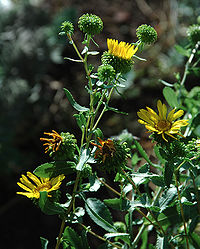
Photo from wikipedia
Gumweed (Grindelia squarrosa) has potential as a biofuel/biomaterial crop in arid lands. Two years of biomass production data at University of Nevada, Reno (UNR) field plots varied from 6700 kg/ha… Click to show full abstract
Gumweed (Grindelia squarrosa) has potential as a biofuel/biomaterial crop in arid lands. Two years of biomass production data at University of Nevada, Reno (UNR) field plots varied from 6700 kg/ha up to 14 900 kg/ha with an average of 9950 kg/ha. Gumweed was planted in 4 m × 4 m plots at spacings of 15, 20, 25, 30, and 37 cm with three replications each. Acetone extraction of the ground, dried biomass yielded about 12.5% extractable hydrocarbons, called biocrude or crude resin. Approximately 52% of the biocrude extract consists of the C20 diterpene acid grindelic acid, which is also approximately 6.5% of the dried plant biomass. Additional carboxylic acids bring the total carboxylic acid fraction to approximately 68% of the biocrude. Also found in the biocrude is approximately 4.7% monoterpenes, including pinene, limonene, germacrene, elemene, and camphene. Acid-catalyzed methylation of the biocrude followed by hexane extraction and removal of the hexane and remaining methanol produced an approximately 72...
Journal Title: ACS Sustainable Chemistry & Engineering
Year Published: 2017
Link to full text (if available)
Share on Social Media: Sign Up to like & get
recommendations!